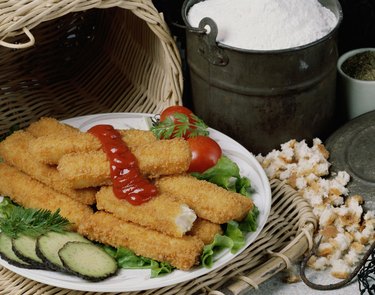
The Centers for Disease Control and Prevention estimates that as many as 72 million Americans are living with obesity. Unfortunately, obesity dramatically increases your risks for health problems ranging from diabetes to cancer. One way to help manage your weight is through your choice of cooking techniques, especially in relation to baking verses frying.
Heat Source
Video of the Day
One of the main differences between baking and frying is the heat source used to cook the food. In baking, heating elements are used to heat the air around a food, which in turn cooks the food in the oven. With frying, heating elements are used to heat the oil that surrounds a food. The heat from the oil is the imparted to the food, cooking it.
Video of the Day
Calories
Because ovens heat air, and air has no calories, baking in an oven does not add additional calories or fat to the foods you cook. This is why baking is a smarter option when working on controlling calorie, cholesterol or fat intake, as you are left only with the calories and fat from the foods in the pan. However, since frying relies on the addition of oil to cook the food, the oil seeps into whatever you are cooking, as well as coats the final product. This means as you consume the food, you also consume the calories and fat content of whatever oil or fat you use to fry your food.
Time to Cook
Another difference between baking and frying is how long it takes to cook your food. The heat from an oven takes longer to cook food than the direct contact of hot oil on your food in a fryer. The short cooking time makes frying ideal for foods like french fries or donuts, but more complicated for larger foods like a full turkey or roast. This is where an oven's size and ability to cook low and slow becomes important. Although an oven may take longer to cook, unless you have a commercial fryer, an oven can cook more food at one time than a traditional home fryer.
Mixing
Along with the additional fat from frying, a fryer can cause other issues with the taste of food. While a fryer can get a crispness that is hard to mimic in an oven, the frying oil can take on the flavor of the foods you cook. For example, frying fish can make your oil take on a fish-like flavor, making anything else you fry in the same oil take on the under-flavor of fish. With an oven, you can cook multiple types of food at once with little risk of affecting the flavor of other foods in the oven.